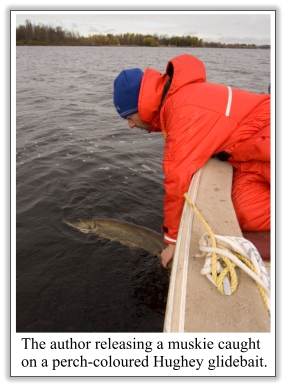
Click Here

Editors & Publishers
T.J. & Monique Quesnel
The
Ontario Fishing Network
E-Magazine is
published 12 times a year on or near the beginning of every month. Our
magazine is geared to any angler who enjoys fishing of any type in the
wonderfully diverse province of Ontario.
Editorial Submissions: We welcome query letters,
but assume no responsibility for unsolicited materials.
Subscriptions: Subscriptions are FREE of charge
and delivered via email. You can subscribe
HERE:
Privacy Policy: Unlike other publications We
NEVER make our subscribers list (your email address) available to any
other companies.
Advertising: If you are interested in advertising
please email us.
Circulation - 7,500 email subscribers
© 2007 Due North
Marketing / Ontario Fishing Network / T.J. Quesnel. All rights
reserved. Reproduction of any material without prior written
permission strictly prohibited.
|
Fall
Muskie Casting
By Tim Allard
 Fall
is a transition period and as autumn leaves change colours, many
anglers switch almost exclusively to trolling for muskies from late
September to ice-up. Yet the fall still holds plenty of casting
opportunities and it's the season for trophy fish. Casting in fall
conditions is tough going; the trick is using effective baits for
the cold water conditions. Here's an overview of some top fall
casting baits with some tips from three Ontario, muskie anglers. Fall
is a transition period and as autumn leaves change colours, many
anglers switch almost exclusively to trolling for muskies from late
September to ice-up. Yet the fall still holds plenty of casting
opportunities and it's the season for trophy fish. Casting in fall
conditions is tough going; the trick is using effective baits for
the cold water conditions. Here's an overview of some top fall
casting baits with some tips from three Ontario, muskie anglers.
Jerkbaits:
You should consider jerkbaits as mandatory lures for any autumn
outing. The surge-and-pause action on lures like Bobbie Baits or
Suicks appeals to the sometimes sluggish disposition of fall muskie.
Gene Kennell, a
well-versed muskie angler from Ottawa, Ontario explained, "The key
to working jerkbaits is long, slow pulls, big pauses, and long hang
time. The more hang time the better," he said. This hang time gives
muskie an opportunity to move in and inspect baits. The next pull of
the lure often triggers hits.
There is no wrong place
to cast jerkbaits in the fall. Prime areas include deep, healthy
weedbeds, sharp breaks, and points near deep water. Having weighted
models is important to be able to count them down to effectively
work deep structures.
 Glidebaits: Glidebaits:
Glidebaits are another good fall choice. They don't require long
pulls of line like jerkbaits. Rather they're worked with a short
twitch, followed by a pause on slack line. This causes the bait to
dart and swim to one side. On the next twitch it will cut to the
other side.
Stacy Ash, owner of Pro
Tackle Musky Charters in the Bay of Quinte area explained, "Glidebaits
give off a slow, dying baitfish action. Their slow presentation can
trigger strikes." He also notes that because baits dart out to the
side, it gives them a large profile, which is a big-time fish
attractor. Popular gliders include Sledges, Hughes River baits or
Phantoms.
I've found glidebaits
to be particularly deadly over top of deep weedbeds. They also do
well anywhere you'd throw a jerkbait.
Minnowbaits and Crankbaits:
Hedrick Wachelka, Muskies Canada Hall of Fame Member and
an avid fall caster, likes baits to maintain a relatively straight
trajectory when retrieved. The straight path makes it easy for
muskie to hone in and hunt the bait. Beyond jerkbaits, minnowbaits,
like Musky Mania Tackle's Jakes or Grandmas, are two of his top
choices for fall casting. He works them on a straight retrieve with
the odd twitch.
Wachelka also uses
crankbaits, like Musky Mania Tackle's Ernies or Joe Bucher's Depth
Raiders, to get down deep near the edges of structure. These baits
trigger hits when banged along rock piles or fished on a stop-and-go
retrieve. He uses baits in both straight and jointed models.
Plastic Baits:
Lastly, large, weighted, plastic baits or swimbaits, such
as Muskie Innovation's Bull Dawgs, Castaic's Swimmin' Sardine or
Storm's Wildeye Swim Shad, are fall favourites for many anglers.
Extremely versatile, these baits can be brought in on slow, steady
retrieves, or allowed to sink to a certain depth and then brought in
on a rise-and-fall pattern. Additionally, they can be fished like
giant jigs, making them an excellent bait to probe deep holes or
drop offs.
Slow
Retrieve:
Regardless of the type of bait, all three anglers expressed the
importance of working them slowly. Wachelka said, "Fish don't feed
as frequently in the fall as they do in summer, so you need to give
them a presentation they won't miss." He notes working baits too
quickly is a common mistake many anglers make come autumn.
Although there are a
variety of baits to cast in autumn, one factor always remains
constant - the importance of powerful hook sets. Cold-water strikes
range from subdued, with the sudden feeling of extra weight on the
line, to shoulder-socket jarring. Act quickly and drive those hooks
home. Fall is trophy time and you might have just hooked the biggest
fish of your life.
|